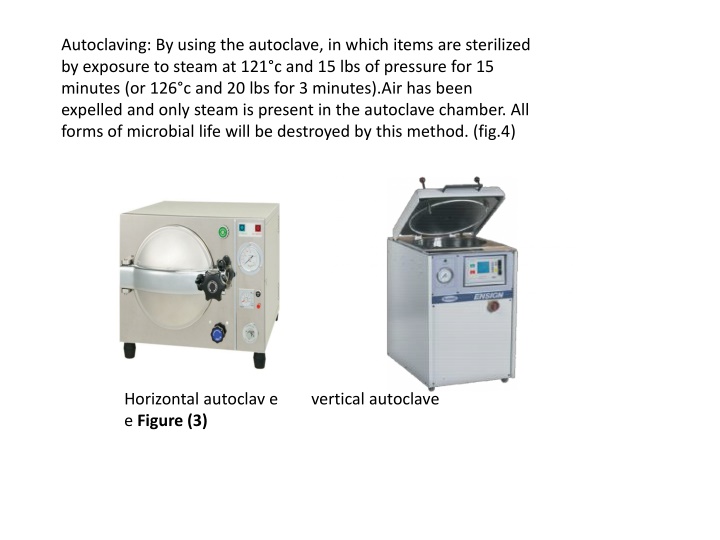
Methods of Microbial Sterilization: Autoclaving, Filtration, and Radiation
Learn about the effective methods of microbial sterilization including autoclaving, filtration, and radiation. Discover how each method works to eliminate microbial life and ensure the cleanliness of equipment and environments. Chemical methods such as disinfectants and antiseptics are also discussed for comprehensive understanding.
Download Presentation

Please find below an Image/Link to download the presentation.
The content on the website is provided AS IS for your information and personal use only. It may not be sold, licensed, or shared on other websites without obtaining consent from the author. If you encounter any issues during the download, it is possible that the publisher has removed the file from their server.
You are allowed to download the files provided on this website for personal or commercial use, subject to the condition that they are used lawfully. All files are the property of their respective owners.
The content on the website is provided AS IS for your information and personal use only. It may not be sold, licensed, or shared on other websites without obtaining consent from the author.
E N D
Presentation Transcript
Autoclaving: By using the autoclave, in which items are sterilized by exposure to steam at 121 c and 15 lbs of pressure for 15 minutes (or 126 c and 20 lbs for 3 minutes).Air has been expelled and only steam is present in the autoclave chamber. All forms of microbial life will be destroyed by this method. (fig.4) Horizontal autoclav e vertical autoclave e Figure (3)
Procedure: 1- Put appropriate amount of water inside the chamber of the autoclave. 2- Adjust the temperature to 121 c. 3- Set the autoclave time for 15 minutes. 4- Place the culture media or other materials that to sterilized inside the autoclave. 5- Close and lock the autoclave door. 6- Start the autoclave by pushing the start button. 7- When the period of sterilization is completed and the pressure in the chamber read O, carefully open the door and remove the containers using heat-proof gloves b-Filtration: Seitz filter (asbestos-paper disc), sintered glass and cellulose membrane filter are commonly used .The pore size of these filters ranges from 0.22-10 m.These filters are used for the separation of bacteria from viruses (bacterial size 2-10 m). Filtration used for sterilization of gases and liquids that would be affected by heat such as serum, antibiotic solutions and the soluble products of bacterial growth, e.g. toxins. (Fig.4) High Efficiency Air Filters (HEPA): Used in operating rooms to remove bacteria from air.
c-Radiation: Three types of radiation kill microbes: c1. Ionizing Radiation: Gamma rays, x rays, electron beams, or higher energy rays. Used to sterilize pharmaceuticals, disposable medical supplies. Disadvantages: Penetrates human tissues and might be caused mutation in human. c2. Ultraviolet light (Nonionizing Radiation): Wavelength is longer than 1 nanometer. Damages DNA by producing thymine dimers, which cause mutations.
Used to disinfect operating rooms, nurseries, cafeterias. Disadvantages: Damages skin, eyes. Doesn t penetrate paper, glass, and cloth. Figure (4) Figure (4)
2) Chemical methods: It act on lipid contents of the cell membrane denaturation of protein, and on nucleic acid, it either kill or stop the growing of microorganism. a)Potent disinfectant: It is toxic and corrosive for living tissue, it s used for nonliving 1) Phenol group: contain benzene ring e.g. bathrooms, hospital, floor ect. 2) Chlorine is most often used in form of sodium hypochloride (house hold bleach) in dilution (1:10) treatment of swimming pools etc. 3) Strong alkaline and acids e.g. NAOH Used for treating sputum for detecting TB and decrease viscosity b) Mild: Antiseptics: It is less toxic and can be applied to living tissue like skin. eg. 1) Detole 2) Chlorhexiden (Hibitane): very good as skin antiseptics used to treat surgical wounds because it work on both gram-positive and gram-negative bacteria. It is widely in dentistry as an antiseptic and plaque controlling agent. It is used highly basic (cationic molecule) very active in 3) Iodine: used in surgery to sterile skin pre-operation. 4) H2O2 (hydrogen peroxide) can be used for sterilization of deep wound or gangrene infected by anaerobic bacteria 5) Soap and detergent. 6) Alcohol at conc.70% because it can penetrate tissue easily at this concentration better than 99 % (absolute) andkill microorganisms by denaturation and dehydration. Growth Inhibition: the purpose of this method is to study the activity of some disinfectants and to learn the importance of time and microbial species in disinfection
- Select one of the chemical agents provided. Add 0. 5ml of the solution in to sterile test tube. 2-To 0.5ml of disinfectant, add 0.0.5ml of Esch. coli or Staph. aureus culture Gently shake the tube. Note the time. 3- Divide Nutrient agar plate in to 4 sections with a marking permanent pen (2, 5, 10, 15) minutes. 4-Transfer one loopful from the mixture of disinfectant culture to a section of the N.A. plate. Lable each plate with the name of m.o., time and the disinfectant, concentration. 5- Incubate at 37o for 48 hours. Phenol Coefficient (PC): The microbiocidal efficiency of a chemical is determined with respect to phenol and is called the phenol coefficient (PC) .The PC is calculated by dividing the highest dilution of chemical (disinfectant) that kills all microorganisms after incubation for 10 minutes, by the highest dilution of phenol that has the same characteristics. Chemicals that have a phenol coefficient greater than 1 are more effective that phenol and those that have a phenol coefficient less than 1 are less effective than phenol








